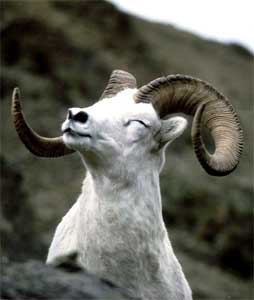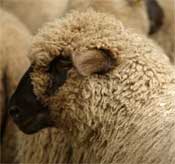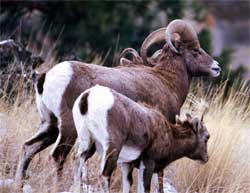
 Lost Sheep: Some breeds of sheep exhibit a strong flocking behavior. This was used as an example to Israelites in the Christian bible to instruct them to obey their shepherd, or master. Flocking behavior is advantageous to non-predatory animals; the strongest animals fight their way to the center of the flock which offers them great protection from predators. It can be disadvantageous when food sources are limited and sheep are almost as prone to overgrazing a pasture as goats. In Iceland, where sheep have no natural predators, and grasses grow slowly, none of the various breeds of sheep exhibit a strong flocking behavior. Lost Sheep: Some breeds of sheep exhibit a strong flocking behavior. This was used as an example to Israelites in the Christian bible to instruct them to obey their shepherd, or master. Flocking behavior is advantageous to non-predatory animals; the strongest animals fight their way to the center of the flock which offers them great protection from predators. It can be disadvantageous when food sources are limited and sheep are almost as prone to overgrazing a pasture as goats. In Iceland, where sheep have no natural predators, and grasses grow slowly, none of the various breeds of sheep exhibit a strong flocking behavior.
 Misbehaving Sheep: Sheep flocking behavior is so prevalent in some English breeds that special names apply to the different roles sheep play in a flock. One calls a sheep that roams furthest away from the others an outlier, a term originally used to refer to someone who lives far from where they work. This sheep ventures further away from the safety of the flock to graze, due to a larger flight zone or a weakness that prevents it from obtaining enough forage when with the herd. Another sheep, the bellwether, leads the others. Traditionally this was a castrated Ram (or wether) with a bell hung off a string around its neck. The tendency to act as an outlier, bellwether or to fight for the middle of the flock stays with sheep throughout their adulthood; that is unless they have a scary experience which causes them to increase their flight zone. Misbehaving Sheep: Sheep flocking behavior is so prevalent in some English breeds that special names apply to the different roles sheep play in a flock. One calls a sheep that roams furthest away from the others an outlier, a term originally used to refer to someone who lives far from where they work. This sheep ventures further away from the safety of the flock to graze, due to a larger flight zone or a weakness that prevents it from obtaining enough forage when with the herd. Another sheep, the bellwether, leads the others. Traditionally this was a castrated Ram (or wether) with a bell hung off a string around its neck. The tendency to act as an outlier, bellwether or to fight for the middle of the flock stays with sheep throughout their adulthood; that is unless they have a scary experience which causes them to increase their flight zone.
 Sheep SAT: According to a spokesperson of the British National Sheep Association, "Sheep are quite intelligent creatures and have more brainpower than people are willing to give them credit for." For example, sheep in Yorkshire, England found a way to get over cattle grids by rolling on their backs. A study published in National Geographic (December 8) showed a sheep can remember the faces of fifty other sheep for over two years. Sheep SAT: According to a spokesperson of the British National Sheep Association, "Sheep are quite intelligent creatures and have more brainpower than people are willing to give them credit for." For example, sheep in Yorkshire, England found a way to get over cattle grids by rolling on their backs. A study published in National Geographic (December 8) showed a sheep can remember the faces of fifty other sheep for over two years.
Close to Home: Sheep can become hefted to one particular pasture so they do not roam far from home. Since the outbreak of foot and mouth disease in the United Kingdom, transplanted sheep have had to be trained to stay in their grazing area.
 Sheep Workers: Raising sheep employed many farmers in ancient economies, given that this animal can give milk (and all its derivative products, such as cheese), wool, sheepskin (used for making footwear, rugs and other coverings) and meat. In the 21st century, sheep retain considerable importance in the economies of several countries. After China, the largest producers of sheep are in the southern hemisphere: Australia, New Zealand and the Patagonian regions of Argentina, Uruguay and Chile. In the UK, the importance of the wool trade was so significant that in the upper chamber of parliament (the House of Lords), the Lord Chancellor sits on a bench known as the Woolsack. The Woolsack is, as its name suggests, a sack of wool and confers the importance of the wool trade to the English economy at the time of its installation. Sheep Workers: Raising sheep employed many farmers in ancient economies, given that this animal can give milk (and all its derivative products, such as cheese), wool, sheepskin (used for making footwear, rugs and other coverings) and meat. In the 21st century, sheep retain considerable importance in the economies of several countries. After China, the largest producers of sheep are in the southern hemisphere: Australia, New Zealand and the Patagonian regions of Argentina, Uruguay and Chile. In the UK, the importance of the wool trade was so significant that in the upper chamber of parliament (the House of Lords), the Lord Chancellor sits on a bench known as the Woolsack. The Woolsack is, as its name suggests, a sack of wool and confers the importance of the wool trade to the English economy at the time of its installation.
In some places, like Sardinia, sheep-breeding has become the principal and characteristic activity.
 The Great Sheep Depression: The economic importance of sheep in much of the United States has declined as it has become, in some cases, economically unviable to ranch sheep for wool. Texas has by far the most sheep of any state, but now has only about one-tenth of the almost 11 million sheep it had in the 1940s. The Great Sheep Depression: The economic importance of sheep in much of the United States has declined as it has become, in some cases, economically unviable to ranch sheep for wool. Texas has by far the most sheep of any state, but now has only about one-tenth of the almost 11 million sheep it had in the 1940s.
War of the Sheep: Even in the 21st century, in some situations, sheep can provide a return on investment of up to 400% of their cost annually (including reproduction gains). Sheep breeding has played a role in several historic conflicts, such as the Scottish Highland Clearances, the American range wars, and the English "enclosing of the commons".

There are many breeds of sheep, but these are generally sub-classable as: wool class, hair class and sheep meat breeds.
 Lovely Sweaters: Farmers develop wool breeds for superior wool quantity and quality (fineness of fibers), wool staple length and degree of crimp in the fiber. Major wool breeds include Merino, Rambouillet, Romney and Lincoln. Lovely Sweaters: Farmers develop wool breeds for superior wool quantity and quality (fineness of fibers), wool staple length and degree of crimp in the fiber. Major wool breeds include Merino, Rambouillet, Romney and Lincoln.
Breeders of dual purpose wool class sheep concentrate on fast growth, multiple births, ease of lambing and hardiness. Drysdale is a sheep bred specifically for carpet wool. An easy-care sheep is the Coopworth that has long wool and good lamb meat production qualities. Breeds of meat sheep include Suffolk, Hampshire, Dorset, Columbia, and Texel.
 A Thousand Trades: One dual-use breed is the Corriedale. Sometimes sheep are used for both purposes equally and cross-breeding is practiced to maximize both outputs. For example, Merino ewes providing wool may be crossed with Suffolk rams to produce lambs which are robust and suitable for the meat market. The Finnish Landrace sheep has a reputation for multiple births. A Thousand Trades: One dual-use breed is the Corriedale. Sometimes sheep are used for both purposes equally and cross-breeding is practiced to maximize both outputs. For example, Merino ewes providing wool may be crossed with Suffolk rams to produce lambs which are robust and suitable for the meat market. The Finnish Landrace sheep has a reputation for multiple births.
Hair class sheep are the original class of sheep in the world, developed for meat and leather. They are prolific and highly resistant to disease and parasites. Dorpers and Kahtahdins are composite breeds of wool and hair crosses with different degrees of wool/hair mixes within the hair class. True hair sheep, are those breeds such as St. Croix, Barbados Blackbelly, Mouflon, Santa Inez and Royal White shed their protective down fiber to an all hair coat in the Spring/Summer. Hair class sheep are becoming more popular for their no-shear aspects.
All text is available under the terms
of the GNU Free Documentation License
|